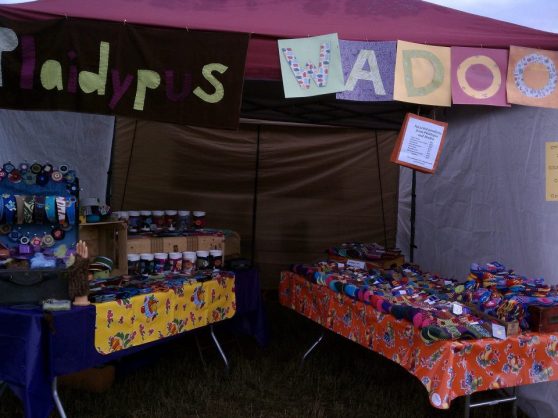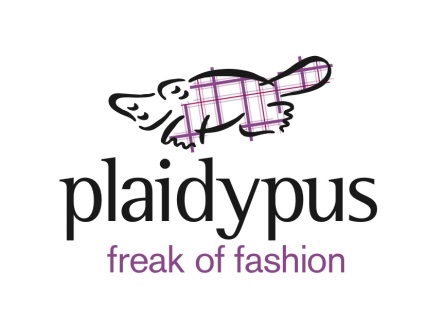Whether you’re a new artist looking to get your business noticed or a veteran artist looking to expand your audience, craft fairs can work for you. Basically, you pay money for a booth or a table and set up shop for a day or a weekend to sell directly to customers, surrounded by other artists just like you.
Plaidypus participates in around four gift shows every year: Fort Collins’ Sustainable Living Fair, Wadoo’s Annual Holiday Trunk Show, The Colorado College Arts and Craft Fair, and the Lux Center Holiday Gift Show. Some years it’s more, some years it’s less, depending on how much time there is to make product and how stressful college (about to be grad school!) is.
I love the craft fair/gift show system for a number of reasons. First of all, people love knowing where their product is coming from, what it’s made of, etc. and you’re standing there able to answer all their questions. Second, you can charge retail price instead of wholesale price for your items (for more information on wholesale and retail pricing, check out “5 Easy Steps to Figure Out Wholesale and Retail Pricing“), which means more profit for your business! Finally, your name gets put in the program, on the website, and on your booth, so you’re getting some great publicity.
Here are the pros of craft fairs in a handy list:

Here’s me telling a friend about a scarf made from sweater sleeves at the Colorado College Arts and Crafts Fair in 2013
Pros of Craft Fairs
1. Connect directly with customers
2. Charge retail pricing instead of wholesale
3. Publicity (even if you don’t make very much money!)
There are also some risks associated with craft fairs. You need to be able to sell enough of your product to pay for your booth fee and your travel expenses for it to be really worth it (unless you’re only going so that you can get your name out there. Then it’s still pretty good marketing/publicity!) Also be aware that many fairs are juried, meaning there is a group of people who decide which businesses get into the fair and which do not, meaning you won’t automatically get into a craft fair. Finally, remember that if your fair is a little further away, you have to take off time, find places to stay, and pay for gas or a flight to get there, which may add to your overhead and make it so you need to sell more (I definitely suggest beginning with local fairs!)
Here’s that list again in, well, list form:
Cons of Craft Fairs
1. Need to sell a lot to pay for the booth fee (booth fees that I’ve seen have ranged from $75 to $1000, depending on the popularity and location of the show, so have a maximum in mind for how much you will pay in case you don’t make the money back)
2. Many are juried
3. Travel expenses and time (plane tickets, gas, hotels, and time off)
So before you decide whether to do a craft fair, remember that sometimes you won’t make as much money as you would selling wholesale to a retail business (I’ll make a separate post about that, soon!). But also remember that it might still be worth it to get your business out there. And you may as well try at least one to see how it goes.
There are many local fairs that you can find that are easy to get to, don’t cost very much (many of them know that they get beginning artists in) and aren’t super big. If you are going to apply for craft fairs, look them up months ahead of time. If you want to do a Christmas craft show, start looking in July. That’s right, some get filled up that quickly. And even if they don’t, it’s good to know ahead of time when everything is due and what you’re going to need to apply. It gives you time to get your materials together and plan your season. 
Finding craft fairs can be a little tricky. Most of the time I pretty much google “gift fairs” or “craft fairs” plus the area I’m looking to sell in. So, I live in Colorado, and I can look up “gift fairs Colorado” and sift through a lot of websites until I find one or two that I can apply for (even if they aren’t juried, you need to send in an application with descriptions and often photos of your product).
The other, more reliable way to find craft fairs is to know people who participate in them already. I personally know a lot of artists who make the majority of their profit from craft shows. I know most people probably don’t have those connections, but the longer you’re in the business, the more connections you will make within the craft world that can give you tips and tricks for your business and for craft shows. You may already know someone who knows someone, and that is a connection worth looking into. (Seriously, don’t worry about asking for help.)

You don’t have to describe it in this much detail. I would say, instead, “coffee cup cozies made from felted wool sweaters.”
There are a few things that almost every application asks for. Here’s a short list in case you want to have everything on hand ahead of time:
Craft Show Application Checklist
1. Product (know what you will sell and describe it)
2. Photos (take photos that show off the product well. Pretty photos are more likely to get you into a juried show)

I might use this as my representative photo of a coffee cozy. It’s uncluttered and shows the item in use.
3. Fee budgets (know how much you can pay for booth fees and have that money ready)
4. Information about your business (name, address, phone number, general statement covering what it is you do, previous shows attended if any)
If you have these things, you should be good to go for most shows. Some may ask you to send in physical copies, including CDs with photos on them, while other will allow everything to be online. Try to find the fair with the highest turnout rate of customers within your budget, because the more people who attend the event, the more potential people to sell to.
And if you have any questions that I didn’t answer about craft fairs, comment and I’ll either edit this post or create a new one! 




 I knew I wanted layers and I knew I wanted buttons (because I like buttons on everything. Who doesn’t like buttons?) so I messed around until I made something I liked and then stuck with that and made a bunch more.
I knew I wanted layers and I knew I wanted buttons (because I like buttons on everything. Who doesn’t like buttons?) so I messed around until I made something I liked and then stuck with that and made a bunch more.


 Here’s one of the first hair clips I ever made combined with the moment I realized how difficult it was to take photos of myself with an SLR camera. At least my hair looked fabulous.
Here’s one of the first hair clips I ever made combined with the moment I realized how difficult it was to take photos of myself with an SLR camera. At least my hair looked fabulous.




